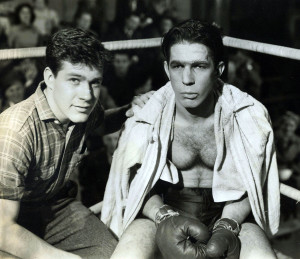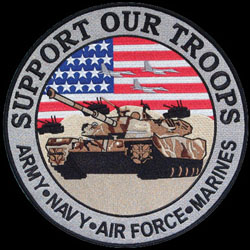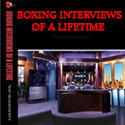
Movie still of Kid Monk Baroni Photo shows Leonard Nimoy, right, in boxing attire with Jack Larson at left.
By Chris Benedict
When I was maybe five or six, Mom drove me to a department store 45 minutes away so that I could meet Leonard Nimoy. Mego was releasing its new line of Star Trek action figures and playsets and Spock himself was putting in a personal appearance at Two Guys (think the 1970s predecessor to Target) to promote them. Mom had a keen eye for advertisements of such events and made sure that I wouldn’t miss it. That’s just the way she was.
We lived a lower middle-class existence so things like toys, comic books, baseball cards, fast food, or a night out at the movies were luxuries in my youth that were damn well appreciated, not expected and taken for granted. Maybe it’s just me, but I believe that the best memories do not and should not cost a lot of money. It’s the simple things in life that matter and make a difference and that you carry with you in your heart and mind for the rest of time. Mom had come across three Starfleet insignia somewhere or other then hit the bargain racks at Sweezy’s to find long-sleeve shirts to sew them onto for me and my brothers. Mine was blue, of course, similar to the one worn by the Enterprise’s Science Officer. I’m sure I was wearing mine that night when Mom treated me to a Mr. Spock action figure which I freed from its carded blister-pack so that I could proudly show Mr. Nimoy his plastic resin likeness when it came my turn in line as if he had never laid eyes on one before. I don’t remember his reaction, but I like to think that he let loose a booming laugh, tousled my hair, flashed the Vulcan peace sign and bid me Live Long and Prosper. He signed one of the black and white 8x10s which sat in a stack on the desk beside him and I find it hard to imagine that Mom did not have a camera ready to snap a picture. If she did, I don’t know what happened to it. Like the autographed publicity photo, the Spock figure and, sadly, Nimoy himself, it is lost to the ages. But the memory remains.
Fourteen long years before he wore the perennially-arched eyebrows and pointed ears applied by legendary make-up man John Chambers (who would win an Academy Award for Planet of the Apes and be portrayed by John Goodman in Argo), Leonard Nimoy was disguised by prosthetics of decidedly more B-movie variety for his first starring role in the little known or discussed 1952 boxing film Kid Monk Baroni.
Bearing a mouth that is slightly askew, a nose bent out of shape by a few back-alley brawls too many and a heavily-ridged, almost simian brow line described later by his manager Mr. Hellman as “atavistic, almost prehistoric”, 19 year-old Paul Baroni is overly sensitive regarding his distinct facial features. “I was not a thoroughly trained actor, but instinctively my emotions began to respond to my new appearance,” Nimoy recalled in his 1975 memoir I Am Not Spock. “I could begin to identify with the internal life of this face-the insecurities, the retiring shyness, the bursts of anger, the paranoia.”
The movie opens in an abandoned Hell’s Kitchen tenement as Nimoy’s “Monk” saws apart a stairwell banister which will be used as kindling to fuel the wood stoves in the otherwise unheated homes of his Billy Goat Gang. Being of the opinion that one of his pals has been looking at him a little too long, Monk smacks his face then tells Knuckles, who menacingly raises a fist in return, “Anytime you want to use it, my office is in the gutter.” They are interrupted by the arrival Father Callahan, the new priest at St. Dominic’s who offers the ruffians use of the church’s basement gym as a more productive outlet through which to channel their excesses of leisure time and violent tendencies.
Monk’s unrefined vernacular (calling the priest “Faddah”) and clumsy attempts to work the speed bag are both corrected by Callahan, urging Baroni to “fight like a man, not like an ape” and become a student of the science of boxing while abandoning the belligerence of the streets. Intolerance, Callahan warns Monk, travels in myriad directions. Once experienced by way of external influence, it can just as easily be internalized and dangerously manifested against oneself.
After performing with the church choir as a much-needed baritone during services, Monk is confronted by the Billy Goat Gang members that he left behind when exiting onto the sidewalk one Sunday and, while defending his friend Angelo, accidentally flattens Father Callahan with a brick. Fearing that he may have inadvertently killed the priest, Baroni impulsively flees the scene and seeks sanctuary, however temporary, in a rail yard before hiding in quite plain sight (especially with his unmistakable mug) as an amateur boxer. This is one of several plot-holes you will be expected to swerve around owing to the negligible navigation of screenwriter Aben Kandel, who also penned the low-budget schlock flicks I Was a Teenage Werewolf (with Michael Landon), How to Make a Monster, and Konga.
Employing crude overhand punches that would have made even Rocky Marciano cringe had he seen the movie, ones which make it appear as though he is swinging a club rather than a gloved fist, Monk lays out his first opponent in a matter of seconds. Leaving him crumpled in a heap where he fell, over the protests of the referee who chastises Baroni for his lack of etiquette, Monk venomously replies that “my defeated opponent can lay there for all I care…they’re booing me, not him.” After hawking the sixth gold watch awarded him after each victory in lieu of a purse, each of which netted him four dollars, the pawnbroker refers Monk to Griffin’s Gym where he is to meet with the renowned manager Mr. Hellman who advises Angelo to have Baroni run around the reservoir, keep him hungry, and check back in a week. Monk’s pro debut is a four-round prelim at the Staten Island Arena which is successfully followed by bouts in New London, Newark, and New Haven.
Not unlike Spock, Paul Baroni is a complex and conflicted character who struggles to reconcile two very different aspects of his existence, a prizefighter who enjoys listening to Gregorian chants, happens to be a voracious reader and graceful dancer. Monk is reunited with a very much alive Father Callahan in the listening room of a local record store and accepts the priest’s invitation to a church social where he again meets the lovely Emily Brooks. Despite telling her that he rather not allow her to attend one of his boxing matches, Paul drives her home and learns that he indeed has competition for her affections to which he laughs that “you may get the chance to see me fight yet.”
Hellman, who makes no secret of his disdain for keeping company with “punch-drunk gargoyles”, partners with an assemblage of bookies and matchmakers called The Syndicate who are seeking a “dirty fighter” to add some rough-hewn diversity to their stable. Watching fight film from Monk’s destruction of “Pretty Boy” Jones in New Haven, one of the Syndicate heavies remarks that “he wasn’t pretty when they carried him out of there.” Although I’ve never heard him say so, I’m going to put forth a wild guess (and aren’t those the best kind to make?) that director and walking/talking film encyclopedia Martin Scorsese had this line in mind when mobster Tommy Como famously says of Tony Janiro “he ain’t pretty no more” after Robert DeNiro’s Jake LaMotta gets through with him in Raging Bull.
Earning bigger paydays in bigger cities, Monk returns to Emily from a road trip to Detroit, New Orleans, and Chicago by counting off, with no emotion, an inventory of “thirty stitches, one busted knuckle, two loose teeth, maybe half a pint of blood, some money too.” He confides in her as to his distaste for boxing, which he equates to “throwing a gorilla into the ring to put on a slaughter-fest” and offers no resistance to Emily’s suggestion that he undergo plastic surgery to rid himself of the “mask” that has obviously caused him so much torment.
“Who punched you pretty?” asks June, the hotel lobby cigar-counter girl whose attention Baroni was previously unable to arouse, leading to a fling that he soon finds is more about spending time in upscale department stores than in her bedroom. Insufferably self-obsessed and rude, Paul has alienated Emily and Angelo, and can no longer afford June’s company, leaving him with “a new face, no friends, and broke”. Hellman tracks Monk down at a ramshackle hotel by “following the trail of unpaid bills” to lure the despondent Baroni, with no money and no other options, back into the ring. Protecting his reconfigured facial features by fighting out of a purely defensive posture, putting on the earmuffs, dancing, covering up and clinching (sound familiar, Floyd?), Monk drops a boring unanimous decision. The Syndicate, needless to say, are less than pleased with his “patty-cake performance” which costs them $10,000, but are convinced by Hellman to string him along.
With Angelo back in his corner, as well as Emily and Father Callahan sitting ringside, Baroni is matched against the “Seattle Wildcat” with a sum total of $25,000 of Hellman and The Syndicate’s ill-gotten gains riding on the result. Consenting to Hellman’s wish that he revert to form and slug it out with the Wildcat as the two go toe-to-toe and exchange the type of relentlessly vicious headshots that only Hollywood allows for, Monk is bloodied and put down for an eight-count before the referee waves the fight off. An apparent double-cross of The Syndicate on the part of Hellman’s having placed side bets on Baroni (another of those head-scratching plot contrivances) allows for the loser’s purse to fund the renovation of St. Dominic’s primitive gym into a Recreation Center for the benefit of the entire community while newlyweds Paul and Emily Baroni enjoy their honeymoon.
Despite a smattering of similarities, Kid Monk Baroni is in no danger of being mistaken for On the Waterfront. “When I first came to California to start a film career,” Leonard Nimoy wrote in response to a 1967 letter from science fiction author Isaac Asimov who was making a case for Spock’s sex appeal, “the current rage was Marlon Brando, who had just won the hearts of the American females by playing a stupid, insensitive boor. Perhaps you’re right-I certainly hope so.” This comment came from a place of great affection for Brando by Nimoy who became infatuated with Marlon, as James Dean and so many others of their generation, while studying the Stanislavskian method of acting and admitted to embracing the white t-shirt and blue jeans worn by Stanley Kowalski in A Streetcar Named Desire as a kind of uniform. He would even direct a production of Streetcar for the Atlanta Theatre Guild.
Almost as though he were giving his review of Kid Monk Baroni, Spock ruminates in the Season 3 episode Squire of Gothos, “Fascinating is a word I use for the unexpected. In this case, I should think interesting would suffice.”
Nevertheless, this film should bring enjoyment to boxing enthusiasts and Trekkies alike. After all, Kid Monk Baroni not only predates but made possible Leonard Nimoy’s celebrated and diverse screen career from Star Trek to Dragnet and Sea Hunt, Wagon Train and Bonanza to Gunsmoke and The Untouchables, The Twilight Zone and The Outer Limits to 26 Men and The Virginian (both of which co-starred DeForest Kelley, The Enterprise’s wisecracking doctor Leonard “Bones” McCoy) to The Man From U.N.C.L.E. opposite future Captain Kirk, William Shatner.
“Each of us, at some time in our lives, turns to someone-a father, a brother, a God-and asks, Why am I here? What was I meant to be?” says an emotional Spock, in Star Trek: The Motion Picture, of the universal conundrum which defies the boundaries of science and logic. The five year-old me was not yet concerned with such lofty concepts and, closing in now on forty-five, I may still be struggling with them but my inner-child and I will always smile in gratitude that Mr. Nimoy heard and answered his calling.
I have been, and always shall be, your fan.
[si-contact-form form=’3′]

 August 16th, 2015
August 16th, 2015  CEO
CEO 
 Posted in
Posted in  Tags:
Tags: 



